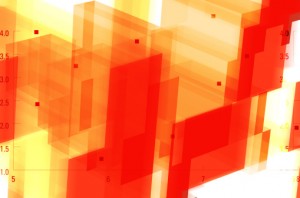The Power of Networks (Part 6)
By Asher Crispe: February 18, 2013: Category Inspirations, Networks of Meaning
 One of the foundational, multi-staged models in Chassidic thought that pertains to our learning development is known as nikudah-kav-shetach or “point-line-area.” In the geometric configuration of our ‘progressions’ within consciousness we begin with a single, isolated idea (especially in the course of an argument or lecture when a person wants to make a ‘point’) which represents the distillation or compactified essence of the matter in question cut out from the tree of associated ideas. Next we attempt to work out a ‘line’ of reason whose linear nature moves us step by step along a fixed bearing (to the exclusion of other directions). Finally, if we broaden our horizons and expand the breadth and length of our of exposition and thereby open up a space which can accommodate many points and multiple lines of reason, we have entered an ‘area’ or ‘field’ of study.
One of the foundational, multi-staged models in Chassidic thought that pertains to our learning development is known as nikudah-kav-shetach or “point-line-area.” In the geometric configuration of our ‘progressions’ within consciousness we begin with a single, isolated idea (especially in the course of an argument or lecture when a person wants to make a ‘point’) which represents the distillation or compactified essence of the matter in question cut out from the tree of associated ideas. Next we attempt to work out a ‘line’ of reason whose linear nature moves us step by step along a fixed bearing (to the exclusion of other directions). Finally, if we broaden our horizons and expand the breadth and length of our of exposition and thereby open up a space which can accommodate many points and multiple lines of reason, we have entered an ‘area’ or ‘field’ of study.
The main advancement of the latter two stages lies in their introduction of connectivity. A ‘line’ is built from linking up a number of points that fall along that a given path as if to say that we will connect to additional points that fit with our original point (while ‘area’ allows multi-directional linking). Our lines of reason tend to embrace additional ideas which can reinforce our premise or proposition (here the propounding or ‘setting forth’ of an idea already implies that it was given a push in some direction). Digressions, interpolations, and associations derail our train of thought. Yet not all derailments result in a crash and burn of the learning process. Carving new paths through an intellectual landscape reveal hitherto unnoticed scenery. Perhaps the only way to become familiar with an ‘area’ is to approach it from all angles or to jump through it so as to demonstrate the immediate connection of parts that at first glance seem to be spatially separated by a considerable amount of distance. While the ‘line’ mentality seeks to keep the mind ‘in-line’ by demanding explanations as to how ‘you got here from there,’ the ‘area’ studies approach permits a person to make rapid leaps of thought due to its’ proclivity for rich interconnectivity.
According to Kabbalah, the first two stages, (point and line), represent two levels of chaos. The study of ‘points’ results in a form of anarchy in that the more clearly we see an idea in and of itself the less we may be able to connect it with other ideas in a collaborative way. Instead the ‘point’ I want to make conflicts with the ‘point’ that you are proposing. Debates that must be won at all costs fall into the fallacy of sophistry amplifying some ideas while quietly ignoring others. Clashing ideas become like hardened impervious dots which might otherwise have turned into potential seeds rather than fight for their continued autonomy. ‘Lines’ of reason do not put us in a much better place. As opposed to the complete chaos of a world of ‘points,’ the linear mindset at least entertains some direct connections. Getting in on the limited partnership would then be comparable to joining an exclusive club. We ‘line’ up for the team and plan our coordinate action. Yet this is still chaotic albeit less so than in the point-like stage. Consequently, the ‘line’ might be comparable to a form of ‘stable chaos.’ Partial connectivity translates into a tempering of the disorder of pure conflict. At least, in this version, there are ‘teams’ who compete using teamwork within the ‘lineup’ of the team. The conflict is supposedly reserved for the other team and all such ‘reasoned’ arguments play out on the court or in the arena of competition as an exciting intellectual contest.
However, the full maturation of any idea happens when it grows out of its embryonic state and limited competitive vision that breaks along lines of rational allegiance and progresses into a new spirit of collaboration. Are not all players valuable? Do not all sides add something to the overall picture? ‘Free’ thoughts swerving through contradiction and paradox often transcend the limits of traditional rationality. We see this in the life of minds in dialogue which stresses the importance of relationships. ‘Areas’ of study expand as these relationships multiply.
Today, we have entered the age of networked knowledge. With the billions of pages and people sounding off online, the clustering of information (which pertains to the idea of partzufim or ‘constellations’ of ideas in Kabbalah) that is dispersed over a wide ‘area’ is beginning to express the astonishing possibilities of radically interconnected ideas. The trail of omnidirectional links can lead virtually anywhere from anywhere. Sewing up the broken ‘points’ of single ideas, the marriage of all in the global brain, bears witness to a foundational unity of all knowledge. While this might appear to be the emergence of a modern day phenomenon, the notion of networked knowledge has its roots in deep antiquity within the inner teachings of the Torah.
Tikunei Ha’Zohar (43b) speaks of Torah scholars as fish in the sea (sometimes we find references to the ‘yam ha’Talmud’ or the ‘sea of the Talmud’). By extension, the entire ‘area’ of Torah study can be compared to an ocean just as the Torah is compared to water (‘ayin mayim eleh Torah’ Baba Kama 82a). As opposed to the stability or static nature of dry land (relationships between areas are clear and fixed), the quality of the ocean of Torah study represents a constant flux and circulations of ideas. The topography of the sea is always changing and continually new each time we experience it. Moreover, we are not just dealing with the surface area of the sea. Moving from point to line is a shift from zero dimensions to a one dimensional space. So too, the transition from a one dimensional line to a two dimensional area necessitates another jump. Yet, area with its two dimensions still cannot reproduce our lived-experience of the real world. For that we need to add yet another dimension so that we can realize a 3D body (guf). In doing so we introduce depth into the field or area of study. And when the entire enterprise is comparable to water, we are cultivating an image of the fluidity of that body of knowledge.
 The massiveness of the fluid body of Torah knowledge (as extensive as it sounds) seems to be but one ocean amongst others. Furthermore, there is still space for dry land (spaces which are not yet integrated or assimilated into the ocean of Torah study). Today, with all of the talk of melting polar ice caps and rising sea levels, we have an environmental concern about flooding. On a spiritual plane however, there is a positive image of a flood which covers all of the land (and effaces the divisions between oceans or bodies of knowledge). Just like the original archetype of a flood in the times of Noach/Noah (which was a destructive flood image), the Zohar (I 117a) states that in the future there will be another flood, only this time it will not literally be with water but with the symbolic significance of water which is knowledge. Specifically, the redemptive waters of this future flood will be a combination of Torah wisdom descending and mixing with the outpouring of new scientific discoveries which will themselves be on the ascension. As we find in Yeshayahu/Isaiah (11:9) this will be a time when “… the earth will be filled with the knowledge of God, as the waters cover the sea.” This powerful expression forecasts an age of ubiquity. Having complete coverage of all the earth by the waters means that the Torah will speak to every facet of life. Like the desert, the ocean de-territorializes the territory of terra firma by opening up non-local connectivity and plugging everything into the web of life which is synonymous with the Torah network.
The massiveness of the fluid body of Torah knowledge (as extensive as it sounds) seems to be but one ocean amongst others. Furthermore, there is still space for dry land (spaces which are not yet integrated or assimilated into the ocean of Torah study). Today, with all of the talk of melting polar ice caps and rising sea levels, we have an environmental concern about flooding. On a spiritual plane however, there is a positive image of a flood which covers all of the land (and effaces the divisions between oceans or bodies of knowledge). Just like the original archetype of a flood in the times of Noach/Noah (which was a destructive flood image), the Zohar (I 117a) states that in the future there will be another flood, only this time it will not literally be with water but with the symbolic significance of water which is knowledge. Specifically, the redemptive waters of this future flood will be a combination of Torah wisdom descending and mixing with the outpouring of new scientific discoveries which will themselves be on the ascension. As we find in Yeshayahu/Isaiah (11:9) this will be a time when “… the earth will be filled with the knowledge of God, as the waters cover the sea.” This powerful expression forecasts an age of ubiquity. Having complete coverage of all the earth by the waters means that the Torah will speak to every facet of life. Like the desert, the ocean de-territorializes the territory of terra firma by opening up non-local connectivity and plugging everything into the web of life which is synonymous with the Torah network.
In Part Seven we will explore what learning and fishing have in common within this ocean of knowledge.
http://www.interinclusion.org/inspirations/the-power-of-networks-part-7/
http://www.interinclusion.org/inspirations/the-power-of-networks-part-5/
The Power of Networks (Part 6),
















;)
;)
;)
;)
;)
;)
;)
;)
;)
;)
